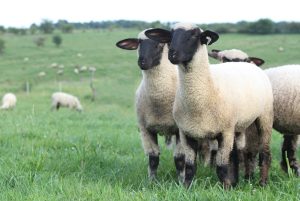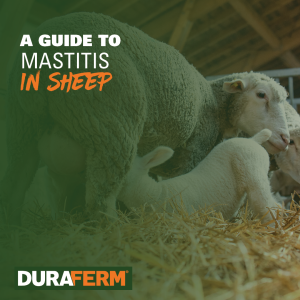
As sheep producers prepare for the upcoming breeding season, Dave Ollila, SDSU Extension Sheep Field Specialist, encourages them to give special consideration to the animal’s body condition.
“Ram fertility is a key component in flock reproductive performance during periods of drought,” Ollila explained. “Reduced ram fertility may result from heat stress and a lower plane of nutrition associated with reduced pasture availability. Along with lower quality water for livestock, drought periods often times also result in limited, poor quality forage.”
He added that it is also very important to have a complete breeding soundness exam conducted on all rams.
Breeding Soundness Exam
A breeding soundness exam should occur at least one month prior to the breeding season. The components of a breeding soundness exam include:
- condition score as evaluated by physically inspecting the ram
- Structural condition of feet and legs
- Fertility as determined by physical palpation of testes and semen evaluation.
“Critically evaluating each component of the breeding soundness exam and addressing those issues at least one month prior to ram turn-out will allow for improvement in body condition if necessary, and determine the number of fertile rams available,” Ollila said.
Body Condition Score
The ram’s body condition is related to overall fitness and fertility. Rams are expected to lose 10-15 percent of their body weight during the breeding season due to the workload associated with the breeding season.
Rams’ body condition should be 3.0-3.5 at breeding time.
This score is typical of healthy-looking rams with the front shoulders blending smoothly into the side, and evenly into the hind legs. Moderate fat thickness should be present and evenly deposited along the spine and on the tail head.
Treating for internal parasites and providing a diet similar to the one offered during the breeding season one month prior to the turn-out day, will allow rams to acclimate better to the physical demands associated with the breeding season.
Structural Soundness – Feet and Legs
A ram must be in good physical condition and structural soundness to remain viable and effective during the entire breeding season.
Examine the ram’s feet and legs for any indication of lameness or structural soundness that could limit ram mobility and ability to mount a ewe. Inspect and trim hooves, this will help reduce the risk of lameness due to cracked hoof tissue.
Keeping rams in a dry area also reduces the risk of lameness, since moist conditions soften hoofs and increase the incidence of lameness due to foot abscesses and abrasions. It is also important to evaluate eyes and teeth at this time to insure the animal is capable of grazing and moving with the flock.
Fertility Evaluation
During drought periods it becomes particularly important to inspect the ram’s reproductive organs for soundness and to have a veterinarian conduct a semen evaluation.
Weather and environmental extremes up to 60 days prior to breeding can impact sperm quality and concentration. Extended periods of temperatures that exceed 90 degrees Fahrenheit or even shorter periods of greater than 100 degrees Fahrenheit can decrease ram fertility.
Heat stress impacts sperm that is developing more than sperm that is already developed and stored.
“The ram, however, must be able to adequately regulate the temperature of the testes by taking them out or bringing them into the body cavity, through the extension or retraction of the scrotum,” Ollila explained.
To help with this regulation, when breeding in months of warmer temperatures, it is recommended to shear the ram at least four to six months prior to the breeding season to remove the wool from the testicles of wool breeds.
During periods of hot weather in the summer including warmer nights, give special attention to providing ample water, shade and natural or artificial ventilation. When possible, avoid rams grouping up in sheds or along windbreaks during hot weather.
Efforts to keep rams as comfortable and cool as possible during the hot summer can pay large dividends by improving flock reproductive performance in the next lambing season. A semen evaluation conducted by a veterinarian will provide critical information on whether the animal is ready for the breeding season.
Semen quality generally is classified into concentration, motility, and percent of sperm abnormalities (dead sperm, detached or crooked tails). A physical evaluation of the testes and epididymis is also important. Abnormalities include irregular shape, and lumps or hardness that may influence sperm production capacity. Rams that fail a fertility evaluation due to semen characteristics should be retested in 30-60 days.
Rams that fail a late-summer semen evaluation will often improve and be considered satisfactory after re-evaluation.
Throughout the breeding season of a drought year, rams should be continually monitored for their breeding activity and body condition to ensure enough ewes are settled in a short time period.
Consider increasing the number of rams used in a breeding group to reduce the risk of a long lambing season and a higher percentage of open ewes. Under normal conditions, a mature or yearling ram is expected to settle 35-45 ewes, but a young ram may only be able to breed 15-20.
“Given the stress associated with drought conditions, consider increasing the number of sires or reducing the ratio of ewes to each ram,” Ollila said. “Size of the breeding groups will also improve breeding success.”
For more information on preparing your rams and ewes for the breeding season contact Dave Ollila, SDSU Extension Sheep Field Specialist at david.ollila@sdstate.edu or Jeff Held, SDSU Extension State Sheep Specialist at Jeffrey.Held@sdstate.edu.
How can BioZyme® help?
DuraFerm™ Sheep Concept•Aid® provides the balanced levels of high quality vitamins and minerals required for optimal growth, breeding and lambing. Organic zinc, copper and manganese, selenium yeast and high levels of vitamin E allow for additional support for maximum reproductive performance and overall health. Providing adequate vitamin, mineral, and trace mineral supplementation are research proven to positively impact fertility.
In addition to a high quality vitamin and mineral pack, Concept•Aid contains the natural prebiotic Amaferm®. Amaferm will allow rams to more efficiently utilize feedstuffs, especially low quality forages, resulting in improved body condition scores. Likewise, more thorough utilization of forages and feeds will better equip rams to maintain their condition better throughout the breeding season while meeting the physical demands needed to cover a group of ewes.
An exceptional nutritional package, combined with the Amaferm advantage, makes DuraFerm Concept•Aid the premier breeding mineral on the market to help sheep producers improve their reproductive efficiency and overall heard performance. Click here to find a dealer near you.

